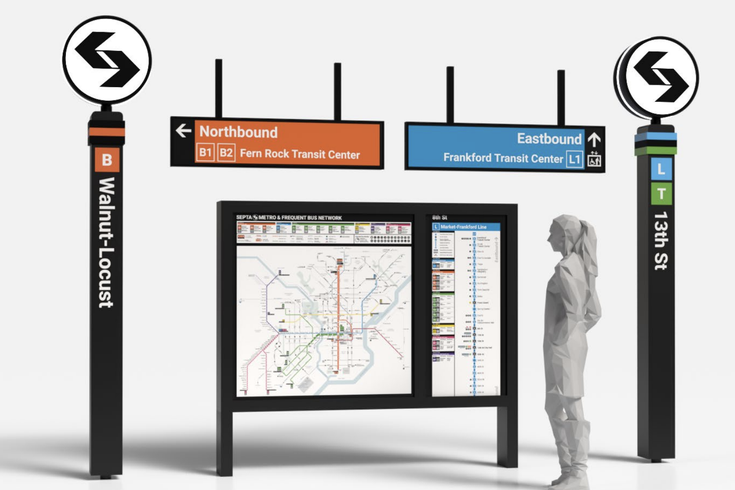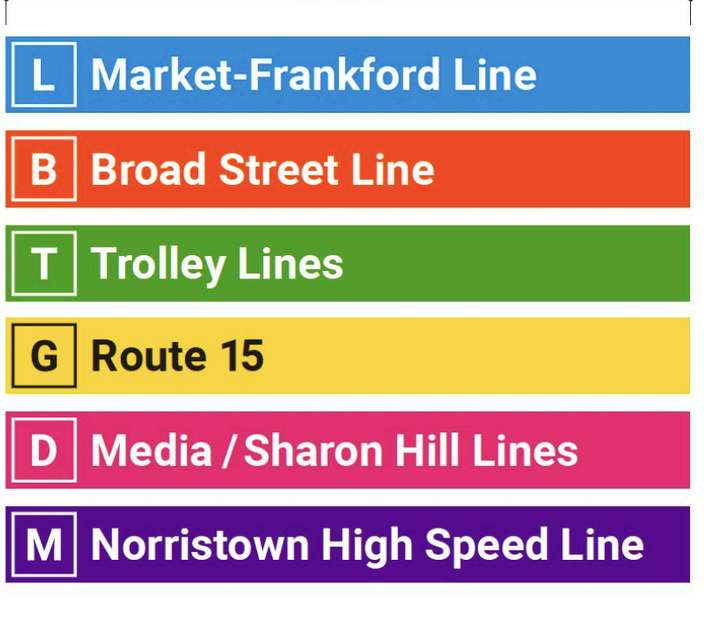
November 14, 2023
 Provided Image/SEPTA
Provided Image/SEPTA
SEPTA's Metro Wayfinding System project aims to make Philadelphia's public transit more user-friendly, incorporating clear signage, colors and letters for enhanced commuter navigation.
SEPTA is taking steps toward simplifying its transit system so it is easier to understand and navigate. Plans include updating SEPTA vocabulary and introducing more consistent signage.
The transit network has unveiled its Metro Wayfinding System, a comprehensive redesign aimed at making SEPTA more accessible and user-friendly for riders on its Broad Street, Market-Frankford, Media-Sharon Hill, Norristown High Speed and trolley lines.
Partnering with the University of Pennsylvania's Center for Safe Mobility, SEPTA conducted a study that used eye-tracking technology to evaluate how people navigate Philadelphia's most confusing transit stations.
The study found that the transit system is plagued by excessive wordiness, reliance on full sentences in signage, overuse of technical terms, inconsistency in station and line names, design disparities, signage placement issues, information overload, outdated data and the presence of multiple brands.
Lex Powers, SEPTA's director of information and design, provided valuable insights into the project's development on Tuesday.
"We've been working on this project for a few years... it really kicked off in the beginning of 2020," Powers said. "The focus on improving the rider experience has been a central theme since the tenure of General Manager Leslie Richards, with an emphasis on correctness, accessibility and consistency in static signage."
Powers discussed the challenges posed by current signage, emphasizing the need for simplicity. "If you go to an airport, for example, you'll notice that the signs use symbols. They're short and sweet, and they all look the same," he said.
SEPTA's redesign prioritizes colors, shapes, letters and numbers to ensure a universally understandable system.
One aspect of the redesign involves adding a new term to SEPTA's lexicon. "Metro," one of three transit categories, will be an umbrella term that refers to the city's Market-Frankford, Broad Street and trolley lines. (The other two SEPTA transit categories will be its bus network and Regional Rail lines.)
Another feature of the redesign is more consistent signage. The Market-Frankford Line will be outfitted with blue signs marked with "L," the Broad Street Line will have orange signs marked with "B" and the trolley lines will have green signs marked with "T." The only outliers will be the Route 15 trolley (currently a bus route that will revert to a trolley line soon), which will have yellow signs with a "G" for Girard Avenue, the Media-Sharon Hill line, which will have pink signs with a "D" for Delaware County and the Norristown High Speed Line, which will have purple signs with an "M" for Montgomery County.
 Provided Image/SEPTA
Provided Image/SEPTASEPTA's Metro transit network will include Philly's Broad Street, Market-Frankford, Media-Sharon Hill, Norristown High Speed and trolley lines.
"We picked all of those shades so that they could be differentiated for different types of colorblindness," Powers said. "The redesign aims to maintain familiarity where appropriate, such as retaining the color green for the West Philly trolleys while introducing new colors for improved differentiation."
Another change will be updating duplicate station names. For instance, the "L" and "B" lines both have stations named "Girard," which will be changed to "Front-Girard" and "Broad-Girard," respectively.
The transit authority also will release a new app, along with new transit maps.
Powers emphasized the importance of providing information in multiple ways, stating, "Being able to provide multiple ways for people to navigate is super important when it comes to disabilities."
SEPTA wants to give the public enough time to understand the changes. The project is expected to begin work next summer, starting with the 15th Street City Hall transit station.
The Metro Wayfinding System's phased approach, attention to user-friendly design and consideration for diverse user needs reflect SEPTA's commitment to creating an inclusive and efficient public transportation experience, Powers said.